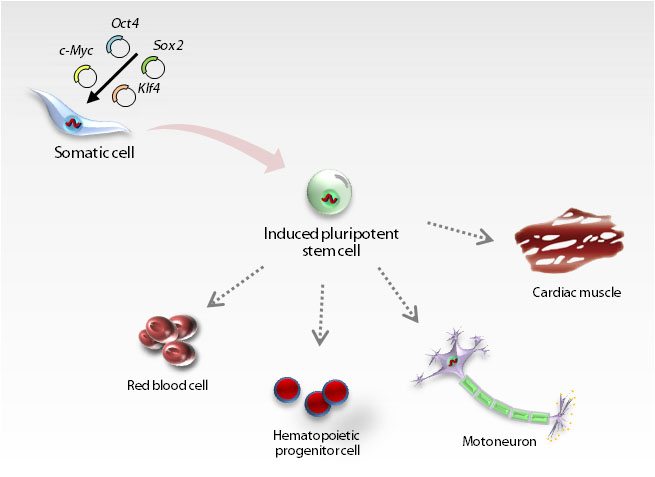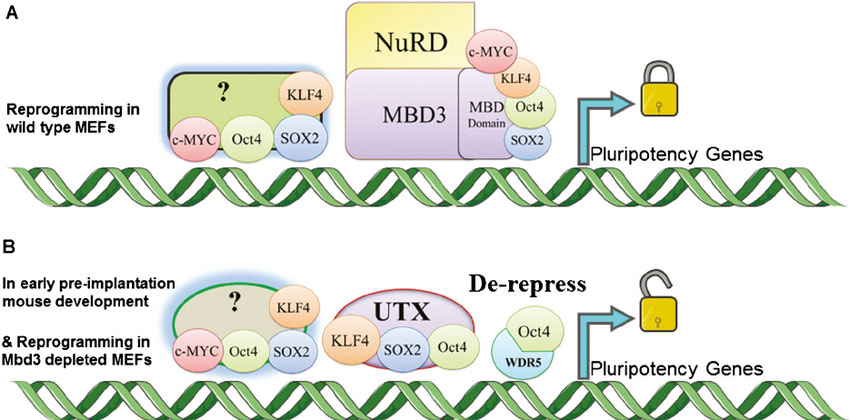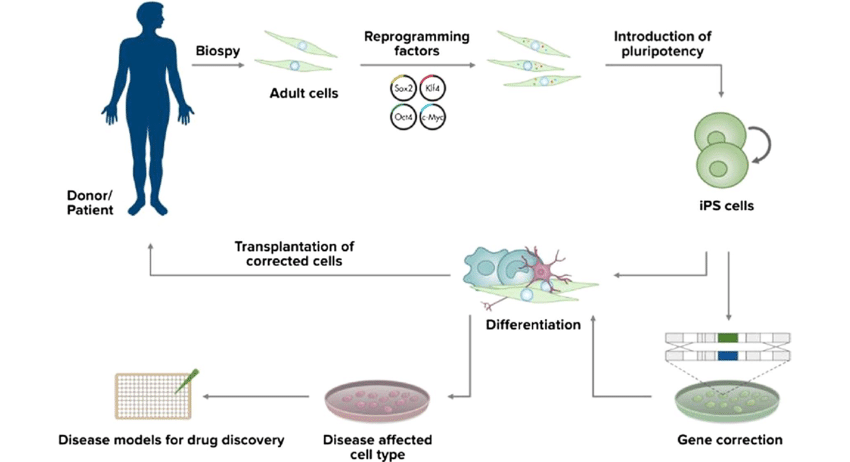Induced Pluripotent Stem Cells – Generation and Cultivation
Induced pluripotent stem cells (iPSCs) are pluripotent stem cells, derived by transducing a specific set of pluripotency-associated genes, or “reprogramming factors” into an adult cell type.
These cells show qualities very similar to human embryonic stem cells. Since iPSCs derived directly from adult tissues, they have the potential to differentiate into tissues. This process not only bypasses the need for embryos but can be grown into tissue individually.
How to generate iPSCs?
There are multiple ways to generate iPSCs, including retrovirus or lentivirus-mediated gene transduction and chemical induction.
The original set of reprogramming factors (also called Yamanaka factors) consists of the genes Oct4 (Pou5f1), Sox2, cMyc, and Klf4, using a retroviral system. The retroviral vectors require integration into host chromosomes to express reprogramming genes, but DNA-based vectors and plasmid vectors do not generally integrate into the cell genome. At the same time, Thomson and colleagues derived human embryonic stem cells by using a lentiviral system with a different set of factors: Oct4, Sox2, Nanog, and Lin28.

Pic 1. the derivation of iPSC
iPSC Generation Difficulty and Solution
iPSC generation is a slow process, and its conversion rate is incredibly low. It takes 1–2 weeks for mouse cells and 3–4 weeks for human cells with the efficiencies as low as 0.01–0.1%. Recently, some optimizations have been made in improving the efficiency and reducing iPSCs derivation time.
Traditionally, the specific fibroblast feeder layers are necessary for the human embryonic stem cells (hESC cells) and human iPSCs culture. The feeder cell preparation requires significant time and effort, can become very labor-intensive and hard to scale. Researchers have developed feeder-free systems for both hES and hiPS cell culture. Extracellular matrix (ECM) proteins such as Matrigel, vitronectin are added into these systems. These ingredients can reduce, even completely separate serum from hESCs and hiPSCs culture without weakening cell activity. To move forward this process, researchers have also designed medium without the requirement of feeder layer cells.
Recently a path involved with Mbd3 was found, which closely related to the reprogramming efficiency. Mbd3 is a subunit of deacetylation (NuRD) that inhibits iPSCs induction. Upon Mbd3 depletion, reprogramming factors are recruited into downstream targets (e.g., pluripotency-related genes) to enhance gene expression, leads to highly efficient the reprogramming to pluripotency. The WDR5 and UTX are essential in reprogramming of Mbd3 -depleted MEFs.
Reprogramming performance can be improved by the consumption of Mbd3, results in iPSC cell reprogramming deterministic and synchronized. The efficiency can also be enhanced significantly to nearly 100% within seven days, from both mouse and human cells.

Pic2. The mechanism of proposed Mbd3/NuRD related reprogramming
How to Culture iPSCs?
We recommend you plate on feeder layer cells. The plating Mouse Embryonic Fibroblasts (MEFs) is mostly used and proved to help keep the stability and viability of our iPSCs. MEFs density ranges from 1 x 105 to 4 x 105 cells in each well (6-well plate). However, the exact MEF density should be determined by individual lab environments. Here we suggest determining MEF density: thaw and plate MEFs at varying densities, ranging from 1 x 105 to 4 x 105 per well. IPSCs were passaged to MEFs and sustained for 5 days, and the tests of morphology, growth rate, and alkaline phosphatase expression were performed to evaluate the iPSC undifferentiated rate maintained by MEFs in each well.
The MEFs should be plated on gelatin 1 day before iPSC plating or at least for 8 hours to ensure optimized density.
The cryopreserved iPSCs should be recovered by 37℃ water bath, then dropwise to 10ml warm medium, mixed and centrifuged. Re-suspend cells medium should be supplemented with 10μM Rho kinase inhibitor(Y-compound), then plated and evenly distributed into MEF covered 6-well plate. The replacement of the new medium without the Y compound should be completed within 20 hours.
iPSC-related Researches and Prospects

Pic3. The brief introduction of inducing and research using of iPSCs
Nowadays, iPSCs have already become a useful tool for disease modeling and drug development, and it shows great potential in transplantation medicine research. Viruses are currently used to introduce reprogramming factors into adult cells. Sometimes in animal studies, the virus used to introduce the stem cell factors possibly causes cancers. We must be carefully controlled and tested before its application into the treatment for humans.
Researchers are currently investigating non-viral delivery strategies. Related transcription factors like miRNAs or small molecules can also be used to replace each of the pluripotency factors for the generation of the iPSCs.
As a well-deserved breakthrough, the iPSC makes cell de-differentiates move one step further. Besides, tissues generated with iPSCs significantly and identically improves the match to the cell donor, probably avoid the immune system rejection. The iPSC can create pluripotent stem cells that possibly develop into any specified cell type, help researchers with cell reprogram and tissue repair in the human body.
AcceGen iPSCs
More research is demanded to discover how much iPSCs could contribute. AcceGen would like to help relative researches to move forward by developing a wider variety of iPSCs products. At the moment, AcceGen has programmed some common starting cell types. We provide iPSCs for donors of different ages, health status, etc. Please see the link below:
https://www.accegen.com/category/induced-pluripotent-stem-cells-ipscs/
For quotations or more information about iPSC products, please call us at 1-862-686-2696 or send an email to inquiry@accegen.com. If neither iPSC meets your demand, our tech support team will help you look for the most suitable product or customize service according to your requirements. Your questions and requests will be answered by the expert staff at AcceGen within 24 hours.
Comments
Post a Comment